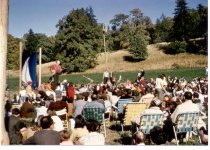Scott, do you really want to move here? We are virtually rioting on the university campus and nearby business locations. Power to the people!
It will make me feel like home. I promise not to do any home invasions.
Last edited:
My memories of 1966
And mine.
An externally hosted image should be here but it was not working when we last tested it.
FWIW, I just bought my son a nice 5" Celestron reflector for his 11th birthday.
Be there Friday, though the realtors insist there are places I do NOT want to live.
Skyline drive by the Equestrian center is nice. Just out of Berkley though.
No riots there yesterday.
For millionaires, its a pretty nice location.
I think the lot was 15K in 1959, suppose inflation took place. Nice for the weekend though.
Cost should be no issue for Scott .....
If (perish the thought) it is .....
He might try Sacramento ....
Be neighbors with me and Steve Eddy
There'd go the neighborhood.
se
PMA:
Is that Pete Seeger in the first pic?
I was married in 1966!!!
Yes, it is Pete Seeger at Hudson river concert in autumn 1966.
The second photo is me at Niagara Falls.
Just the Berkeley Hills, if you can afford it, is safe, beautiful, and closely located to everything, Scott. I hope you are successful in your quest.
Almost bought a place there 10yr. ago but the commute to San Jose would not work. We're just looking for a 2/3BR. empty nester condo for now to try this out.
The second photo is me at Niagara Falls.
Niagara Falls!!!!!! Slooooooowly I turn, step by step, inch by inch....
I meant IATD as an additional example of "unexpectedly" small time resolution numbers that people naively want to use to imply 100-200 kHz "hearing"
Ah, ok - i misunderstood it in that context.
Kunchur's models don't require modifying "conventional" psychoacoustic understanding of high frequency sensitivity - he is ascribing the increased time resolution to the result of a convolution like process from phase locking of frequency content totally within conventional < 20 kHz human hearing limits
His explanation of filtered 7 kHz square wave results do appeal to possible 21 k
Hz nonlinear mixing, 14 kHz in band IMD – but not to direct sensitivity of hearing the 21 kHz fundamental
Isn´t that exactly what Kunchurs data imply?
AFAIR he measured the upper frequency limit of his participants and even those listeners with a quite limited frequency range could detect a variation in the ~5-6µs region.
But in the production of music content- do we have another chance to enhance the temporal resolution as to raise the sampling frequency?
On the Slot ref – “sharpness” in psychoacoustics is correlated with increased high frequency content – rising sensitivity with frequency above ~ 3 kHz
So sharpness sensitivity to filter order for corner frequencies below our upper frequency hearing limit is “conventional” psychoacoustics – care to post what filter corner frequencies he was citing?
I don´t have that in my archive- Thorsten L. and John Curl cited from the book.
Let me add a point to the sample size and inference statistics. It just deals with probabilities and it is more likely that a random sample is located somewhere around the mean of the underlying distribution in the population than in the extreme ends.
It is normally unusual in psychoacoustic studies to have sample groups that are really representative and sufficient large.
That explains sometimes (furthermore complicated by different test signals, presentation and so on) why the variance between different studies is often quite large, see for example the evolution in the case of "contours of equal loudness" :
Full Revision of International Standards for Equal-Loudness Level Contours (ISO 226)
So, we have to be careful; due to the physiological mechanism the overall function is similar but the the interindividual variation can be substantial.
Niagara Falls!!!!!! Slooooooowly I turn, step by step, inch by inch....
Huh?
se
- Status
- Not open for further replies.
- Home
- Member Areas
- The Lounge
- John Curl's Blowtorch preamplifier part II

